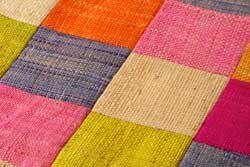Organic Fabric - Why Is It A Smart Sewing Choice?
There is a growing trend among environmental and health conscious people towards using organic fabrics.
But
what makes a fabric organic? Just like with food, farmers grow the plants used
for these fabrics without any pesticides or chemical fertilizers.

Farmers use plant and animal based fertilizers and insect repellents to keep the plants healthy and productive.
Steps for production must meet the many regulations set by the Organic Trade Association.
The Perfect Fabric Choice For Our Bodies And The World Around Us!
Unlike commercial fabric production, organic fabrics do not produce by-products that can harm the environment such as polluting fish, global warming and other ecological damage.
Many producers use sustainable practices which reuse almost all the chemicals used in turning the source material into fabric ready fibres.
These producers treat animals used for animal based fabrics like wool humanely and do not overload them with antibiotics, steroids and insecticide dips. It’s important to note that these fabrics biodegrade naturally over time, whereas synthetic fibres can let off dangerous toxins as they degrade and become waste.
What Are The Benefits?
Enjoy The Comfort
There are many other great benefits to using environmentally friendly fabrics as well. These natural fabrics simply feel better when you are wearing them. They are soft to the touch and are breathable against your skin. Many of these eco friendly fabrics are also labeled hypoallergenic.
So Many Fabric Choices!
There are many choices when it comes to choosing an organic fabric. Organic cotton is becoming more and more common.

Another popular choice is linen , which is made from fibres from the flax plant. Hemp fabric is also growing in popularity, though there are some political issues with hemp which may make it hard to find or more expensive than it might otherwise be.
Bamboo is turned into an incredibly soft and supple fibre that works great in knits. Soy can also produce a fibre for making furniture, stuffing, batting and garment fabrics. As for animal based fabrics, you can find organic wool, silk, yak down and other more exotic animal fibres.
What Is Organic Fabric Used For?
Organic fabrics can be used in a huge range of applications, including furniture, clothing and accessories, stuffing and crafts. These environmentally friendly fabrics are better for the earth and for your health. They don't give off smelly and carcinogenic fumes, and are just more natural.
These fabrics are a little more expensive than their non-organic counterparts, but an increasing number of people believe it is worth it to make the switch.
Related Articles
Go to CreativeSewingTips.com Home Page




